Our Packs
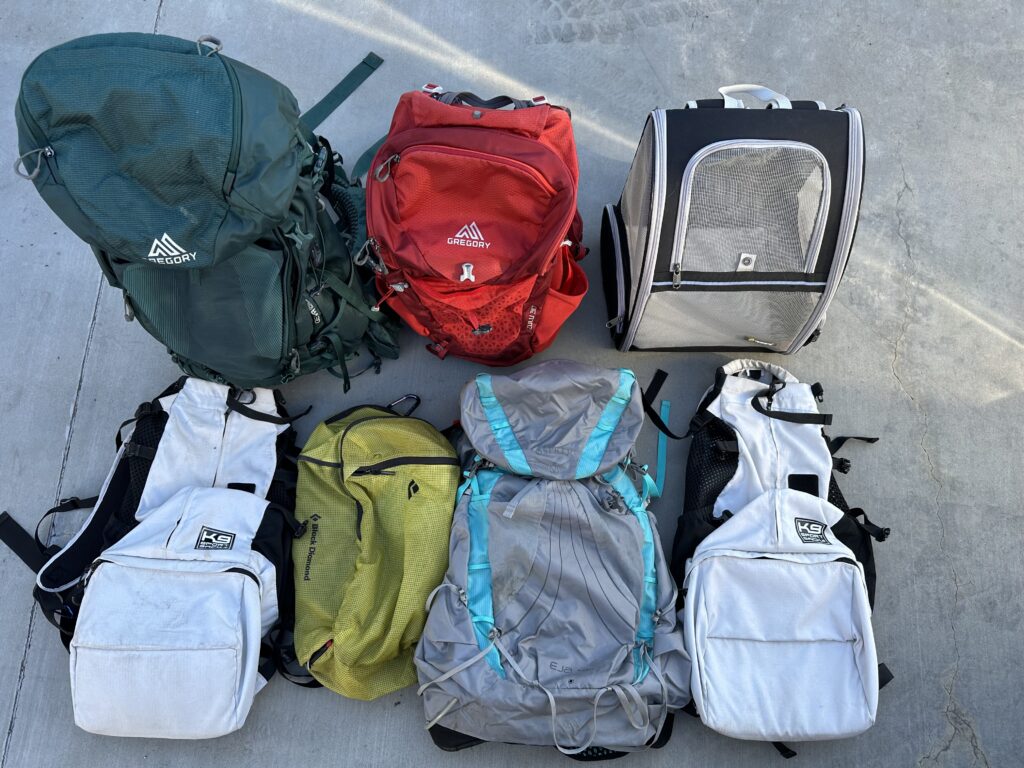
These are our packs, our primary pieces of safety gear. They allow us to carry the items we determine are necessary for every hike. Each pack has a specific purpose. We select the packs, which will best fulfill our needs for every hike. Yes, we do live full-time in a 25′ Leisure Travel Van https://hikingmemere.com/our-gear-list-leisure-travel-van/, and yes we have found room for all of them in our RV.
Items we carry in our packs are a balance of weight and necessities. The more a pack weighs, the more tiring it is to hike. Carrying ten pounds is much different than carrying thirty pounds. We do not skimp on weight when it relates to safety. Our safety gear fits in all of our packs and is always with us. We carry extra food, water, and clothing. On top of this, we add specific items when necessary, like hand warmers or bear spray.
My dark green Gregory is my long trail multi-day pack. It is easy to wear and can hold large amounts of gear. My red Gregory is my everyday pack. It is as comfortable as its big brother and the perfect size for whatever a day hike demands of us. Jess loves her mid-sized grey Osprey. She carries it for multi-day trips and any time we need a little more storage space on a day hike. It is versatile and lightweight making it a great pack.
The green Black Diamond pack is the newest and has become our favorite mountain biking backpack. It’s comfortable and compact. It is big enough to carry extra water and all of our safety gear. Additionally, we carry an assortment of tools and a bicycle tire pump. These tools give us the ability to make basic repairs trailside.
Pet Carriers
The boy’s (our two fifteen-year-old cockapoos) packs are the white K-9 Sport Sacs. https://www.k9sportsack.com/collections/dog-carriers/products/k9-sport-sack-knavigate?variant=40055549263930 Our dogs liked them instantly and we are frequently asked about them on the trail. Both dogs were mighty hikers when they were younger, logging many trail miles. As they have aged, it became necessary to help them out. These packs were the perfect solution. Cleo’s (our 15-year-old, mixed-breed Siamese cat) pack is on the end of the top row. It’s roomy and the screening gives her a nice cool ride.
Our Safety Gear
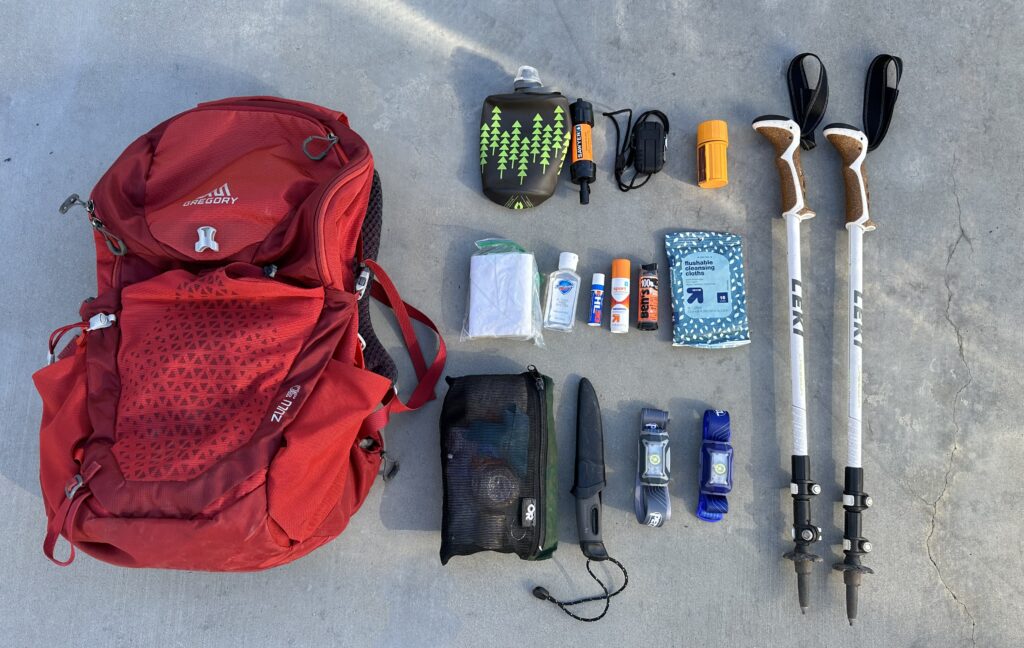
This is our safety gear. To me gear is as personal as clothing, what is a great fit for us may not be right for everyone. Many of these items have been in our packs for years. These are our essentials they accompany us on every adventure we take long or short. Safety gear is one step in experiencing the best nature has to offer.
Starting on the top row is our water filtration system. It is a very simple filter to use. First, we fill the black bag with water. Second, the bag is connected to the filter. Lastly, water is squeezed into a water bottle or can be drank directly from the filter. The next two items are a windproof lighter and a dry canister, containing wooden matches. In a situation requiring an unexpected night in the wilderness having the ability to make a fire could make all the difference.
I would classify the next row as our preventative safety gear. These items help us stay healthy and safe long term. TP, hand sanitizer, and wipes ensure we can maintain proper hand washing. Bug spray is a simple way to protect ourselves from a variety of mosquito-borne illnesses. SPF lip gloss and suntan lotion are a necessity at high elevations and in desert climates.
The green bag is our med kit. It is Jess’s creation and I will describe it in detail later. My knife is general purpose and contains a flint in the handle. We carry two head lanterns, and extra batteries if we are hiking for an extended amount of time.
Trekking poles
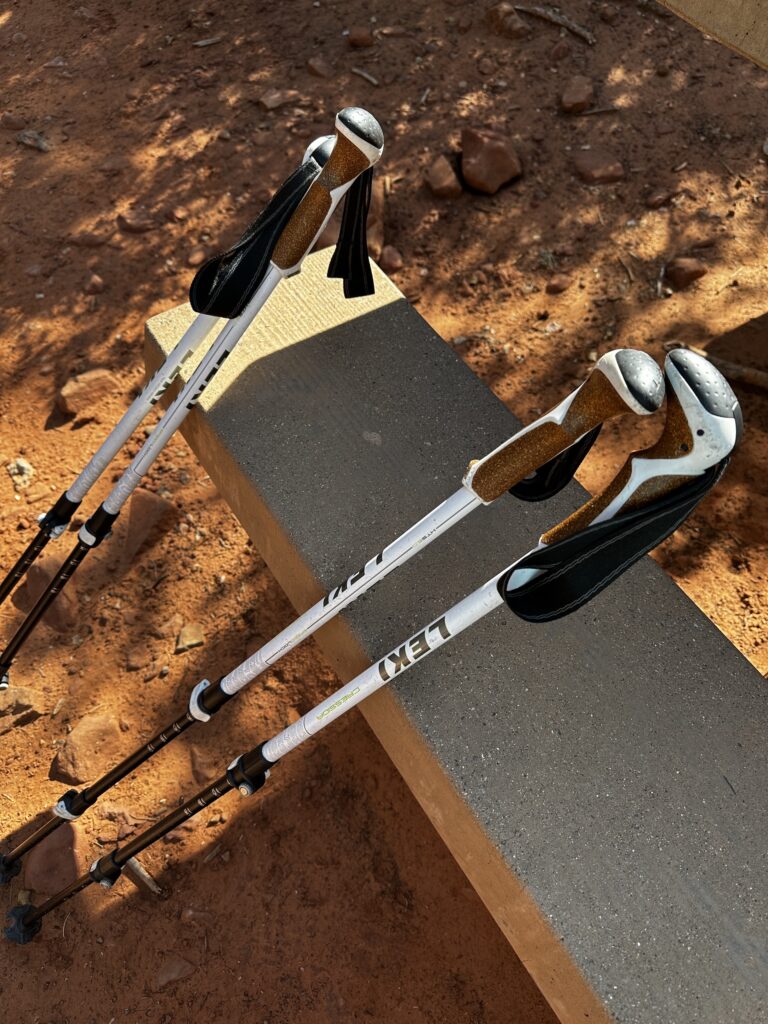
Our Leki Trekking poles are my favorite piece of safety gear. I love the stability they provide. They are fully adjustable. Sometimes, I adjust their heights throughout a hike based on the terrain and depending on whether we are traveling uphill or down. They provide two additional points of contact with the ground and I have avoided many falls. Another advantage of trekking poles is the alleviation of stress on my knees when I descend steep terrain. In a medical emergency, we could use the poles to help immobilize an arm or leg or assist like a crutch. The light weight and versatility of this simple item justifies their cost.
Our med-kit
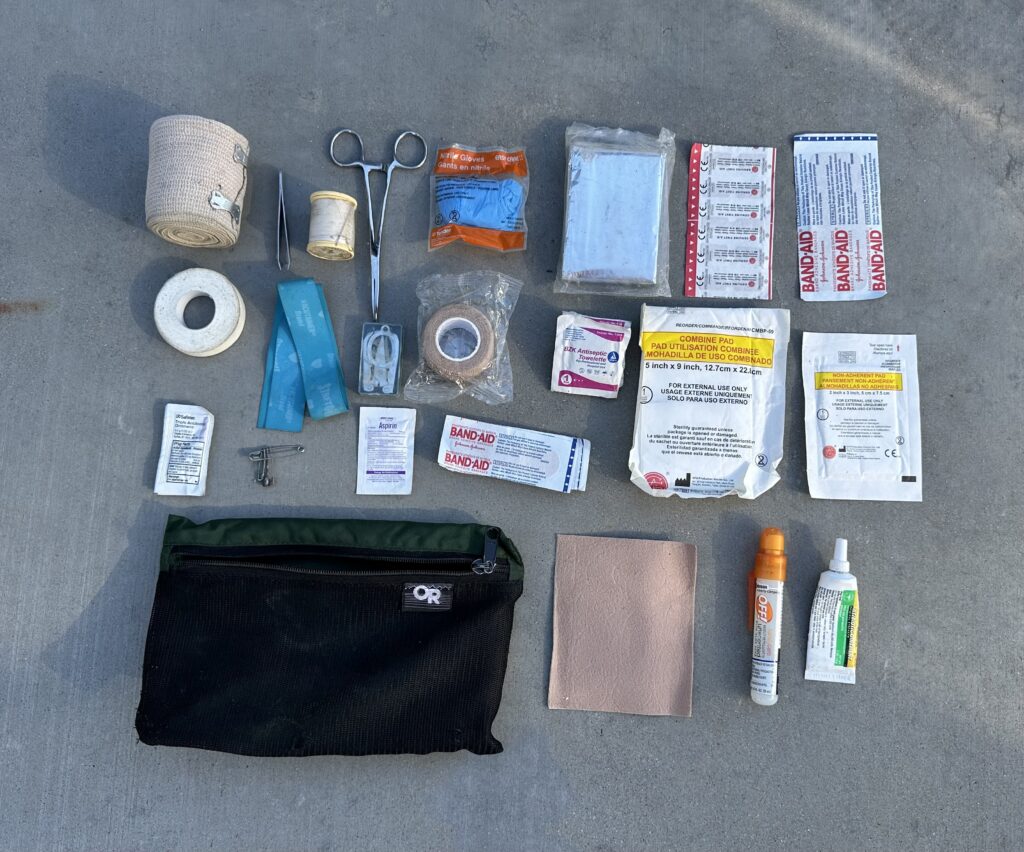
Our med kit is an important part of our safety gear. It contains items we use regularly like triple antibiotic ointment and band aids as well as items we hope to never need. The top row starts off with an ace bandage. Yes, it has been used more than once. Tweezers, scissors, needle and thread. Yes, all used! Gloves, Emergency Blanket, sterile strips, and tourniquet. Thankfully, not used! Assorted band-aids, gauze, tape, moleskin (blisters), antiseptic wipes, aspirin and safety pins. Yes, all used!
Slips, falls, and trips happen if you hike as much as we do. Our primary goal is to prevent injury first by hiking appropriate terrain and being as careful as possible. If an injury should occur we want to have the items needed to provide basic first-aid to ourselves or another hiker who may need help.
We have assisted many hikers with scrapes and cuts using our med kit. I chuckled on a hike up Mt. Moosilauke in New Hampshire when a doctor, who had hiked the trail, was asking all the hikers at the top for salve to soothe his “chub rub”. Of course, I had some! Having the right tools in our safety equipment to help another hiker in distress makes me happy and is good Karma!
Hiking safety Preparedness
Hiking Safety is important to Jess and I. We feel safety is more than what we carry in our packs. It is a mind-set. Being prepared is the first step in being safe. Every hike presents its own set of challenges. We have had our share of mishaps and dangerous situations while hiking. Our decision-making and our gear have prevented these situations from becoming serious. We do our best to anticipate problems and be self-reliant.
Research
Research is one of the best ways to minimize risk when hiking. Today there are many ways to acquire accurate and current trail information. With a couple of clicks on my phone, I can read trail descriptions. Look at maps of the area and find parking lot locations. This was not always possible. I used to have to buy a trail guide or map to learn the trails in an area. My AMC (Appalachian Mountain Club) comprehensive guide to the White Mountain National Forest complete with maps, logged as many miles as we did. I wore out the heavy-duty waterproof maps, leaving holes in the seams from the enormous amount of use.
When we moved from Maine and started playing in the mountains of Colorado, I had to adjust my reliance on physical maps. The sheer volume of hikes and maps that were available was overwhelming. What I learned is that with modern phone apps, I could find detailed information about any trail we wanted to hike. In addition, I could read real-time trail descriptions and opinions from many different hikers. This information was concise and easy to understand.
The Physical
One of the most important things about researching a trail is the physicality of the route. Is this trail within our technical ability? What is the mileage? How much elevation gain? What elevation is the trail? When Jess and I first started hiking together, I wanted her to enjoy it. I hoped she would eventually love it as much as I did. I picked trails with lots of great views, interesting terrain, and reasonable amounts of effort. The more types of terrain we hiked the better I could gauge our physical abilities.
These days we have hiked all of the 4000 footers in Maine and New Hampshire, (3) 14000′ peaks in Colorado, many miles of the Appalachian trail in several eastern states, and have been adding many more miles of trails throughout our travels across the country. We mix and match our hikes. Somedays we want to physically challenge ourselves. Other days we want to go to an iconic place or hike a historic trail.
Turn around Times
Some situations we have been in have not been clear-cut and we have had to make judgment calls. Do we continue or do we turn around? Turn-around times help keep hikers safe. A turn-around time is simple, after researching the hike and understanding the risks a hiker can choose to self-impose a turn-around time. If you have not reached the top by that time you simply turn around and begin your descent, regardless of how close you are.
For example, hiking in the White Mountains of New Hampshire, summits were above tree line. Summertime thunderstorms typically roll in around one in the afternoon, when this happens being above tree line is a dangerous place. Jess and I use turn-around times in our desert hiking adventures also. We try to hike early in the day when it is cooler and ensure we are headed back to our vehicle before the hottest day parts. If we are attempting a hike potentially more strenuous than our ability, we will decide before we begin when we will turn around.
Turning around on a hike is something most hikers do not want to do. Hikers who push themselves too far may end up in a serious situation requiring the assistance of others. A turn-around time that you have thought about and decided, before the adrenaline and desire to reach the top of the mountain has taken over, can be just enough to keep you safe. We have had many situations in which we have turned around, both on day hikes and multi-day hikes. I have never regretted the decision.
Weather
Research also needs to include what the weather will be. What is the elevation of the hike? Does this hike have any unique weather concerns? For example, a slot canyon. Knowing what to expect throughout the hike determines what we bring and wear for clothing. It also helps us understand if we need additional gear.
On the top of Gray’s Peak a 14278 mountain in Colorado, we encountered a woman who was freezing close to the summit. She had begun her descent, but it would take her a couple of hours to return to the safety of her warm vehicle. We were able to give her several hand warmers, an item we were carrying specifically for that hike, to help keep her more comfortable.
Understanding the expected weather also helps us decide how much water to carry. The general rule is you should drink one liter of water, for every two hours of moderate level hiking. More is recommended if you are hiking at higher elevations, or in hot climates. The weight of that water adds up quickly. At about 2.2 lbs per liter, a full-day hike could require over ten pounds of water. Dehydration and heat stroke are both serious conditions, which can lead to requiring assistance. Water is an item we never skimp on. It is the most frequent item we give away to other hikers.
Tell Someone Where You Are Going
The final step is ensuring someone knows where you are going and how long you will be gone. This can be done with a simple text. In the event of a serious accident, time is critical. If no one knows where you are, or where you are supposed to be, no one will be looking for you!
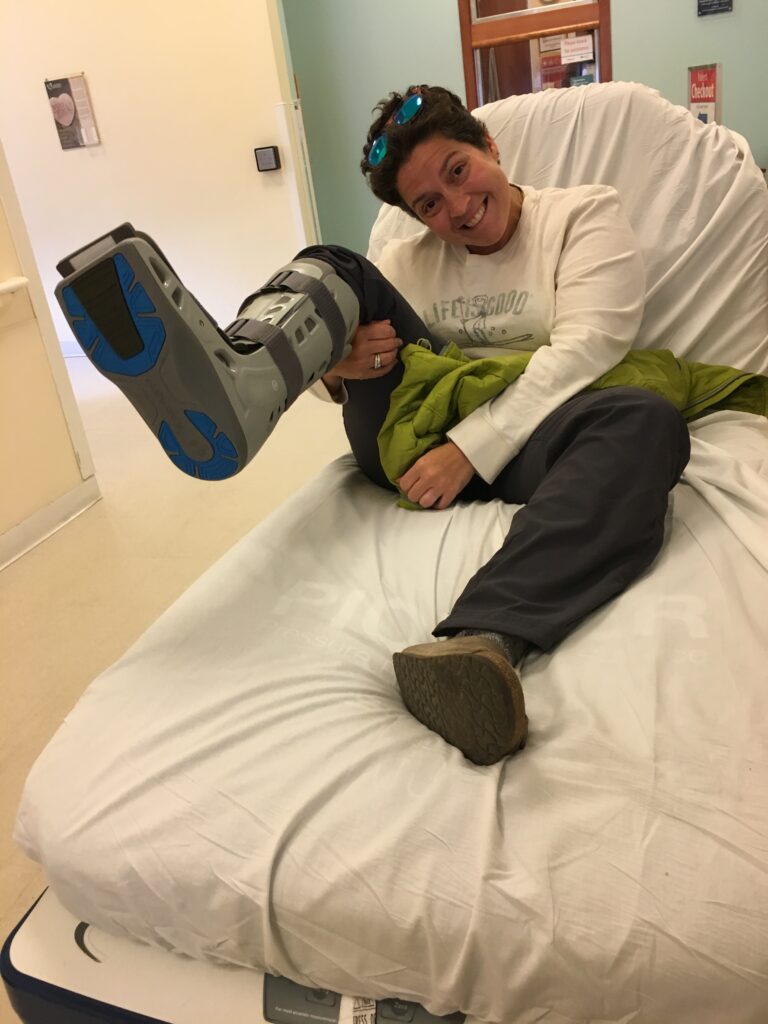
Accidents Happen
We were descending an enormous slide on the Mt. Coe trail in Maine. It was late in the afternoon and the strenuous trail compounded with the hot day had us running low on water. When we reached the stream in the valley, we decided to stop, take out our water filtration kit, and fill our water bottles. Even though we had less than two miles of trail remaining, across terrain which was much less difficult than every part of the hike we had already completed. We chose to take the time to do it anyway.
On the last mile of our descent, Jess suddenly fell. She had taken a step on the leaf-covered ground, and the sloped side of the trail collapsed towards the ravine. After the initial shock of the situation, we knew she had a serious injury. We sat there for a few minutes discussing our options, then we decided to stay together and try to walk out ourselves. We immobilized her ankle with athletic tape and an ace bandage. Together with some Tylenol, it was the best we could do. Our hiking poles helped provide additional support as we hobbled our way down the trail.
We were prepared!
As late afternoon turned to dusk, we put on our headlamps. I was thankful we had filled our water because what should have taken us less than an hour had now taken several hours. We had an injury, but we had food, water, and additional clothing. If we had to spend the night in the woods we were prepared to do so. By the time we reached our car, it was late. Jess decided a glass or two of wine back at the lean-too and some ice from our cooler would be sufficient for the night. This allowed us to travel many miles for an X-ray in the daylight hours.
After her doctor’s visit, we found out she had a high ankle sprain and was in a cast for many weeks. This situation is a great example of how people can quickly find themselves in trouble. Preparation prevents a small mishap from becoming a serious problem. Our situation could have turned out differently. If we did not have our safety gear, we would not have been able to get ourselves out of the woods. I would have had to go for help and leave Jess on the trail. If we hadn’t filled our water or packed extra clothes, even though we knew it was supposed to be a hot day, time could have become more of a problem. She would have been there sitting on the side of the trail alone in the dark, with nothing, waiting for me to come back with help.
This situation was easily resolved with deliberate steps and lots of enduring on Jess’s part.
Choose Safety
My final thoughts on hiking safety. Don’t skimp on food and water. Bodies need fuel to hike, food is fuel. Bring your safety gear. Know your limits. Decide on a turn-around time and stick to it. Stay on the trail! Bad things happen when people try to take shortcuts. Have a map or a good map program you can use offline. Know the predicted weather forecast and have appropriate clothing. Tell someone where you are going and when you will return. Make good decisions. Take a friend and get out there and start exploring!
This is a very interesting read. Lots of great information. I know a lot of planning goes into hiking, but never quite realized the extent. Great work.
Thank you. We have quite a few people that ask about different pieces of our gear. We thought for some this may be helpful!